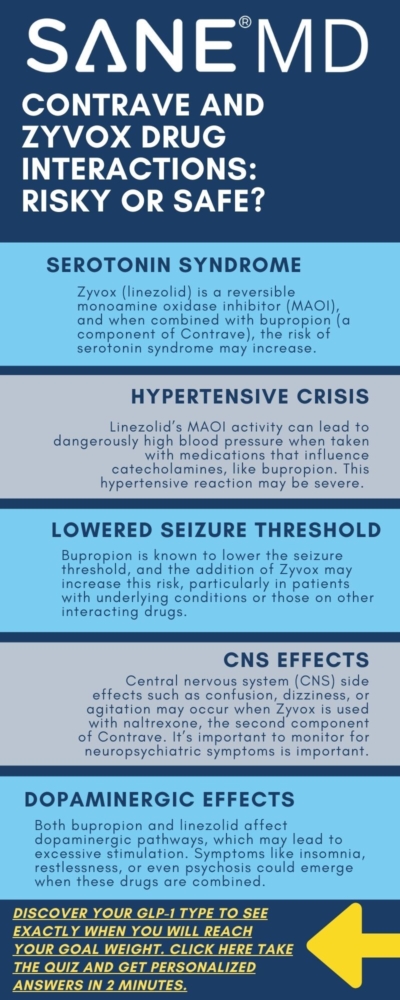Contrave and Hydromorphone Drug Interactions: A Risky Combo?

As more people turn to medications to manage weight and chronic pain, concerns about how these drugs may interact are becoming increasingly important. One such potential concern is the combination of Contrave and hydromorphone drug interactions.
Contrave, a prescription medication for chronic weight management in certain individuals, combines bupropion hydrochloride and naltrexone in extended-release tablets. If you’re wondering how long the effects of Contrave last, you can read more about how long Contrave stays in your system. Hydromorphone, on the other hand, is a powerful opioid analgesic used to treat moderate to severe pain. While both drugs serve distinct purposes, their interaction can pose serious health risks.
In this article, we’ll explore the pharmacology of both drugs, discuss the potential drug interactions, highlight risks such as the risk of seizures, opioid withdrawal symptoms, and high blood pressure, and offer guidance on what to discuss with your doctor before combining treatments.
Key Takeaways
- Combining Contrave and hydromorphone may increase the risk of serious health issues, including seizures, opioid withdrawal, and high blood pressure.
- Certain individuals, especially those with a seizure disorder, bipolar disorder, or severe hepatic impairment, face even greater risks.
- Always talk with your doctor before starting or adjusting medications to prevent adverse reactions and ensure your safety.
Understanding Contrave
Contrave is approved for use in certain obese or overweight patients who have an initial body mass index (BMI) of 30 kg/m2 or greater, or 27 kg/m2 with at least one weight-related condition like high blood pressure or Type 2 diabetes. Contrave works for weight loss by combining two active ingredients:
- Bupropion hydrochloride, an antidepressant also used to treat depression and quit smoking.
- Naltrexone, an opioid antagonist commonly used to treat opioid dependence and alcohol use disorders.
Together, bupropion naltrexone targets brain pathways related to hunger and reward, supporting weight loss for compatible individuals when combined with a reduced-calorie diet and increased physical activity.
But like other weight loss drugs, taking Contrave is not without risks. The drug carries a boxed warning that alerts doctors to the potential for suicidal thoughts in some patients, especially during starting Contrave treatment or dose changes. It can also increase the risk of seizures, particularly in those with eating disorders, uncontrolled high blood pressure, or a seizure disorder.
Hydromorphone: What You Need to Know
Hydromorphone is a potent opioid used to manage moderate to severe pain. It is often prescribed after surgeries, for cancer pain, or for individuals with chronic pain conditions who are opioid-tolerant. Hydromorphone carries its own risk profile, including physical dependence, accidental overdose, and opioid withdrawal.
Importantly, naltrexone—one of the components of Contrave—blocks opioid receptors. When someone taking Contrave receives opioids like hydromorphone, the opioid’s effect can be reduced or entirely blocked. This can trigger opioid withdrawal symptoms in people dependent on opioids or cause inadequate pain control in those with no opioid dependence.
Why Contrave and Hydromorphone Don’t Mix
The combination of Contrave and hydromorphone is considered potentially dangerous due to how these drugs interact within the brain and body. Both medications have potent effects on the central nervous system, and their overlap can produce harmful outcomes.
Below are the key reasons why this mix should be approached with extreme caution:
1. Risk of Seizures
One of the most serious concerns when combining Contrave with hydromorphone is the heightened risk of seizures. Bupropion doses—a component of Contrave—are already known to reduce the seizure threshold, meaning they make seizures more likely, especially at higher doses or when taken by individuals with eating disorders, bipolar disorder, or a history of seizures.
Hydromorphone, as a powerful opioid, also affects the central nervous system and may further lower the brain’s seizure resistance.
When used together, the compounding effects can lead to a dangerously increased seizure risk, even in patients without a diagnosed seizure disorder. Those already predisposed to seizures are at especially high risk and must be monitored closely.
“Patients taking Contrave should be closely monitored when other central nervous system medications like opioids are added, due to changes in the seizure threshold,” says Dr. Matthew Olesiak, Chief Medical Director at SANE MD. “The interaction can become especially volatile if there are underlying neurological risk factors.”
2. Opioid Withdrawal
Contrave contains naltrexone, an opioid receptor antagonist that blocks the effects of opioids in the brain. While this action is useful for supporting weight loss and treating opioid dependence, it presents a serious issue for anyone currently taking opioid medications like hydromorphone, morphine, hydrocodone, codeine, etc.
If naltrexone is taken by someone who is physically dependent on opioids—even if the last opioid dose was taken several hours ago—it can rapidly displace the opioid from the receptors, leading to symptoms of opioid withdrawal.
This withdrawal can be intense and sudden, with symptoms such as nausea, vomiting, sweating, tremors, anxiety, muscle aches, irritability, and insomnia. For those with chronic opioid use or opioid dependence, the experience can be medically dangerous and emotionally distressing.
Importantly, even low-dose or recent opioid use can result in these opioid withdrawal symptoms when combined with Contrave. Because naltrexone can remain active in the body for some time, knowing how long Contrave stays in your system can help patients and providers avoid unexpected withdrawal.
This makes it essential to talk with your doctor and fully disclose any recent or ongoing opioid use before starting Contrave treatment.
3. High Blood Pressure and Cardiovascular Strain
Another major concern is the increased risk of cardiovascular complications. Taking Contrave has been shown to cause elevations in blood pressure and heart rate due to its bupropion component, which influences the serotonergic neurotransmitter system and inhibits norepinephrine reuptake.
Hydromorphone, although a depressant, can cause fluctuations in cardiovascular function, including hypotension (low blood pressure) or rebound hypertension (high blood pressure), especially when pain levels are not properly managed.
When these medications are combined, they may create unpredictable blood pressure responses and place significant strain on the heart. This risk is particularly serious for individuals with uncontrolled high blood pressure, heart disease, or a history of chest pain or stroke. In worst-case scenarios, the combination could precipitate a cardiac event.
“We already know that bupropion inhibits norepinephrine reuptake, which can increase both heart rate and blood pressure,” explains Dr. Olesiak. “When you add opioids to the mix, you increase cardiovascular risk, especially if the patient has pre-existing risk factors.”
Even for those without diagnosed cardiovascular conditions, monitoring blood pressure during Contrave treatment becomes essential, especially when combined with other drugs that affect the heart.
Additional Red Flags
Suicidal Thoughts and Psychiatric Concerns
One of the most concerning side effects of taking Contrave is its potential to increase the risk of suicidal thoughts, especially during the early stages of treatment or when doses are changed. This risk is particularly elevated in younger adults, adolescents, and those with existing psychiatric conditions like bipolar disorder or major depressive disorder.
Bupropion, one of Contrave’s active ingredients, acts on neurotransmitters that regulate mood and behavior, which can sometimes lead to mental health destabilization in vulnerable individuals.
When combined with opioids like hydromorphone—known for their sedative and mood-altering properties—the potential for psychiatric side effects increases. This combination may worsen mood swings, emotional instability, and even lead to dangerous decision-making behavior.
Individuals with a personal or family history of psychiatric illness should be carefully evaluated before starting Contrave treatment and should talk with their doctor about any emerging mental health symptoms, including trouble sleeping, agitation, or dark thoughts.
Physical Dependence and Withdrawal
Both Contrave and hydromorphone can influence the brain’s reward and adaptation systems, although through very different mechanisms. Hydromorphone, as a narcotic analgesic, carries a high potential for physical dependence and can lead to withdrawal if suddenly discontinued.
Contrave, especially due to the bupropion doses, may also lead to withdrawal symptoms such as irritability, anxiety, and cravings if stopped abruptly—especially in patients who are also using it to quit smoking or treat depression.
When used together, these drugs can confuse the body’s adaptive responses, making withdrawal more intense or erratic. If a patient is already dependent on opioids and begins taking Contrave, the naltrexone component can precipitate acute opioid withdrawal symptoms, which are not only unpleasant but can be medically dangerous.
Gradual dose adjustments and close medical supervision are essential when stopping either drug, and patients should never discontinue without a clear tapering plan set by their provider.
Other Drug Interactions
Can Contrave interact with other medications? Unfortunately, the answer is “yes.” Many patients taking Contrave are also managing other health conditions like diabetes, hypertension, or anxiety—and are therefore often on multiple medications. This increases the chances of certain drug interactions with Contrave, particularly when combining over-the-counter drugs, other medications, or even herbal remedies. Some drugs may increase the risk of side effects by affecting liver enzymes that process Contrave, while others might alter its efficacy or trigger unpredictable reactions.
For example, decongestants can elevate blood pressure, increasing the danger of hypertension in patients already at risk. Antidepressants like Effexor and Prozac, stimulants like Ritalin and caffeine, or antipsychotics may enhance central nervous system stimulation, raising the risk of seizures or mood disturbances. Even some dietary supplements marketed for weight loss may interfere with bupropion naltrexone.
These overlapping effects can be unpredictable—and potentially dangerous—when multiple medications are used together, especially without close monitoring.
According to a 2023 study published in Medicina, 85.3% of patients taking two or more medications simultaneously had at least one potential drug-drug interaction. Similarly, a 2014 study in PLOS ONE found that 70% of elderly patients engaged in polypharmacy, with over 10% experiencing adverse drug reactions.
Always provide a full list of medications and supplements to your healthcare provider and talk with your doctor before starting Contrave in a polypharmacy context.
High-Fat Meals
Food intake—specifically high-fat meals—can significantly influence how Contrave is absorbed. Research has shown that consuming a high-fat meal can increase bupropion exposure, potentially raising serum drug levels and intensifying side effects. This elevated exposure further lowers the seizure threshold, which is already compromised in patients on Contrave.
When opioids like hydromorphone are introduced, the overlapping effects on the central nervous system can compound these risks, making side effects like dizziness, sedation, or confusion more likely.
Patients should be advised to take Contrave with a low-fat meal or on an empty stomach to reduce risk. The medication guide also warns against high-fat food intake during Contrave treatment, especially when patients are also using other drugs that impact the central nervous system.

Allergic Reactions and Skin Rash
Although rare, allergic reactions can occur with Contrave, ranging from mild skin rash to more serious reactions involving swelling, difficulty breathing, or hives. These reactions are more likely when the immune system is activated by multiple other drugs, especially those known to trigger histamine release. Combining Contrave with hydromorphone—which can also cause histamine-related side effects—may amplify the risk of an allergic response.
Clinical data and post-marketing reports have documented instances of allergic reactions, including skin rashes, among patients using the bupropion/naltrexone combination therapy. According to the FDA product monograph for Contrave (the brand name for bupropion/naltrexone), common dermatologic adverse reactions (occurring in 1% to 10% of patients) include hyperhidrosis and rash, while uncommon reactions (0.1% to 1%) encompass alopecia.
Patients with a history of medication allergies should, therefore, be cautious and talk with their doctor about their history before taking Contrave. Any new skin changes, itching, or respiratory symptoms should be reported immediately to prevent serious adverse reactions.
Who’s Most at Risk?
Some individuals face a significantly increased risk of complications when taking Contrave alongside opioids or other medications.
You may be in a higher-risk category if you:
- Have a seizure disorder or a history of seizures: Your risk of experiencing a seizure is already elevated, and Contrave can further reduce your seizure threshold.
- Are taking other CNS stimulants or sedatives: This includes medications for ADHD, sleep disorders, anxiety, or mood stabilization. These can interact with bupropion or hydromorphone and amplify side effects.
- Have bipolar disorder or psychiatric conditions: The mood-modulating effects of both drugs can trigger suicidal thoughts, manic episodes, or emotional instability.
- Have uncontrolled high blood pressure: Contrave is known to raise blood pressure. When paired with opioids or other medications, this can heighten your risk of cardiovascular complications.
- Are pregnant or breastfeeding: Both bupropion and naltrexone may pass into breast milk, and their effects on infants have not been fully established. Pregnant or nursing patients should avoid Contrave unless clearly needed and prescribed under careful supervision.
- Are already dependent on opioids: Taking Contrave while using opioids like hydromorphone can trigger sudden and severe opioid withdrawal symptoms, which can be medically dangerous.
Safe Use Guidelines
Talk With Your Doctor
Before taking Contrave, always talk with your doctor, especially if you’re already taking opioids. It’s essential to disclose all medications, including over-the-counter drugs, herbal supplements, and other medications, to prevent Contrave interactions.
Start Low, Go Slow
This approach helps monitor patients for any worsening side effects or new symptoms. Gradual titration, especially when starting Contrave treatment, can help reduce the risk of seizures and ensure tolerability.
Avoid Alcohol
Drinking alcohol while taking Contrave can lower the seizure threshold and amplify central nervous system effects. Patients who suddenly stop drinking alcohol are at even greater risk.
Follow the Medication Guide
Always read the FDA-approved medication guide and follow the instructions carefully. Note the importance of not skipping your scheduled dose or taking more than your next scheduled dose.
Frequently Asked Questions (FAQs)
Combining weight loss medications like Contrave with pain relievers—especially opioids—raises important safety questions. Whether you’re managing chronic pain, post-surgical discomfort, or simply need a temporary painkiller, it’s crucial to understand the potential interactions and risks.
Below are answers to commonly asked questions about taking Contrave with opioids and other pain medications.
1. Can I take Contrave with HYDROcodone?
It is generally not recommended to take Contrave with hydrocodone or any opioid medication. Contrave contains naltrexone, an opioid receptor blocker, which can interfere with the effects of hydrocodone. This interaction can lead to reduced pain relief or even trigger sudden opioid withdrawal symptoms in individuals who are physically dependent on opioids.
Always talk with your doctor before combining these medications.
2. Can you take hydromorphone with bupropion?
Caution is advised when taking hydromorphone with bupropion. Both drugs can affect the central nervous system and may increase the risk of seizures, especially in those with a seizure disorder or bipolar disorder. Additionally, bupropion may intensify the effects of opioids or interfere with pain perception.
Always talk with your doctor if you’re prescribed both medications to determine the safest approach.
3. Can you take Contrave with opioids?
No, taking Contrave with opioids is not considered safe without medical supervision. The naltrexone in Contrave can block opioid effects and cause opioid withdrawal, even if the opioid was taken hours earlier. This interaction can be physically distressing and potentially dangerous.
Patients who need pain management with opioids should talk with their doctor before starting or continuing Contrave.
4. What medications should not be taken with Contrave?
Several types of medications can cause harmful Contrave interactions. These include opioids, such as hydrocodone, monoamine oxidase inhibitors (MAOIs), other antidepressants, and medications that lower the seizure threshold, such as antipsychotics or stimulants. Drugs that affect blood pressure, insulin or oral diabetes medications (due to the risk of low blood sugar), and over-the-counter drugs like decongestants can also pose risks.
Always provide your doctor with a full list of other drugs you’re taking, including supplements and herbals.
5. Can you take painkillers with Contrave?
Non-opioid painkillers like acetaminophen (Tylenol) or ibuprofen (Advil) are typically safe to use with Contrave, but opioid-based painkillers are not. Because Contrave blocks opioid receptors, combining it with opioids may result in ineffective pain relief or trigger opioid withdrawal symptoms.
If you’re in pain, talk with your doctor to find safe alternatives that won’t interfere with your Contrave treatment or increase health risks.
Final Thoughts
When used as prescribed, both Contrave and hydromorphone can provide therapeutic benefits. However, Contrave and hydromorphone drug interactions are not something to overlook. From opioid withdrawal symptoms and high blood pressure to risk of seizures and suicidal thoughts, the combination can be dangerous, especially without professional oversight.
Taking Contrave alongside opioids like hydromorphone should be avoided unless under direct medical supervision. Whether you’re pursuing clinically meaningful weight loss or managing pain, your health depends on open communication.
Always talk with your doctor to weigh risks, manage side effects, and choose the safest path forward.
Disclaimer: This article is intended for informational purposes only. It does not substitute professional medical advice, diagnosis, or treatment.
Sources

Contrave and Propranolol Drug Interactions & Side Effects

Understanding Contrave and propranolol drug interactions is crucial for individuals using these medications for weight loss and blood pressure management. According to the FDA, Contrave is a prescription weight-loss medication that combines bupropion naltrexone to help certain individuals with a reduced-calorie diet and increased physical activity (FDA).
Propranolol, a beta-blocker, is commonly prescribed for high blood pressure, heart conditions, and anxiety medicines (NIH). When used together, these medications can result in possible interactions, which may affect blood pressure, blood sugar, and mental health.
Dr. Matthew Olesiak, Chief Medical Director at SANE MD, states, “Patients should inform their healthcare provider about all other drugs and dietary supplements they are taking before starting Contrave treatment, as beta-blockers like propranolol may interact with bupropion naltrexone in ways that require medical supervision.”
Key Takeaways
- According to the CDC, combining Contrave and propranolol may result in an increased risk of irregular heartbeat, high blood pressure, and changes in blood sugar (CDC).
- Both bupropion and propranolol affect neurotransmitters, potentially leading to worsening depression, mood swings, and mental health changes.
- Consulting a healthcare provider before initiating bupropion and propranolol together is essential to avoid serious skin reactions and cardiovascular risks.
What is Contrave?
According to the FDA’s prescribing information, Contrave is an FDA-approved prescription medication for weight loss. It is designed for compatible individuals with a high body mass index (BMI) or weight-related medical conditions (FDA).
It combines two active ingredients:
- Bupropion – An aminoketone antidepressant that helps regulate appetite and energy balance. It is also used to treat depression and aid in smoking cessation.
- Naltrexone – An opioid antagonist primarily used in treating opioid dependence and alcohol addiction, but in Contrave, it helps modify cravings.
Contrave, shown to help individuals lose weight, is prescribed in combination with a reduced-calorie diet and increased physical activity. However, the FDA warns that it comes with potential risks, such as increased blood pressure, risk of seizures, and serious skin reactions (FDA).
Patients should avoid alcoholic beverages and narcotic medicines, as these can lead to possibly dangerous interactions.
What is Propranolol?
According to the NIH, propranolol is a non-selective beta-blocker that is widely prescribed for high blood pressure, heart conditions, and anxiety medicines (NIH).
Propranolol blocks beta-adrenergic receptors, diminishing the effects of adrenaline and lowering blood pressure and heart rate.
Uses of Propranolol:
- High blood pressure management – Helps reduce hypertension and cardiovascular risk factors (CDC).
- Heart rhythm disorders – Used to control irregular heartbeat and prevent heart attacks.
- Migraine prevention – Can help reduce the frequency and severity of migraines.
- Anxiety treatment – Often prescribed to manage symptoms of anxiety medicines, including rapid heartbeat and tremors.
- Thyroid storm – Used in hyperthyroid patients to control symptoms such as palpitations.
Although propranolol is effective, the NIH notes that it may cause serious skin reactions, flu-like symptoms, and worsening depression in some patients (NIH). Individuals taking propranolol should avoid alcoholic drinks, as alcohol can enhance its sedative effects.
Healthcare providers must monitor for blood sugar fluctuations and possible interactions with other drugs, especially when used with Contrave. Patients should follow prescribed dosages and never stop propranolol suddenly, as it may result in a rebound effect, increasing blood pressure and heart rate (NIH).
Contrave and Propranolol Drug Interactions & Risks
| Interaction Type | Potential Effect | Recommendation |
|---|---|---|
| Blood Pressure Variations | Unpredictable fluctuations, dizziness, irregular heartbeat | Regular blood pressure monitoring, consult a healthcare provider |
| Mental Health Changes | Increased risk of worsening depression, anxiety, mood swings | Monitor for mental health changes, report concerns to a doctor |
| Cardiovascular Risks | Higher risk of irregular heartbeat, chest pain, fainting | Discuss cardiovascular history before taking both drugs |
| Risk of Seizures | Bupropion naltrexone lowers seizure threshold, increasing risk of seizures | Avoid sudden medication changes, stay hydrated, consult a doctor |
| Effects on Blood Sugar | Can cause low or high blood sugar, especially in diabetics | Regular blood sugar checks, adjust medications as needed |
| Serious Skin Reactions | Rash, flu-like symptoms, systemic exposure reactions | Stop medication if symptoms occur, seek emergency care |
| Alcohol Interactions | Increased drowsiness, risk of seizures, worsened mood changes | Avoid alcoholic beverages, discuss with a doctor |
| Medication Adjustments | Propranolol should not be stopped suddenly, risk of rebound high blood pressure | Gradual dose adjustments under medical supervision |
Possible Drug Interactions
When taking Contrave and propranolol together, understanding their possible interactions is essential for safe medication use.
While Contrave is primarily prescribed for losing weight, it affects multiple neurotransmitters, metabolism, and blood pressure regulation. Propranolol, a beta-blocker, alters cardiovascular function and is often used for high blood pressure, anxiety, and heart conditions.
Because both medications impact the central nervous system, cardiovascular system, and metabolic pathways, combining them may increase the risk of seizures, cause mental health changes, or trigger serious skin reactions.
Below are key possible interactions that patients should discuss with their healthcare provider before starting Contrave treatment alongside propranolol. These side effects of Contrave and propranolol drug interactions can be severe, so you should seek medical attention if needed.
1. Blood Pressure Variations
Since bupropion naltrexone in Contrave can increase blood pressure, while propranolol works to lower it, their combined effects may result in unpredictable fluctuations. Individuals with high blood pressure or pre-existing cardiovascular conditions should take extra caution, as these changes can cause symptoms such as:
- Dizziness or lightheadedness due to sudden blood pressure shifts
- Rapid or irregular heartbeat
- Chest discomfort or shortness of breath
- Headaches or blurred vision associated with high blood pressure episodes
To prevent complications, regular blood pressure monitoring is recommended. If unexpected blood pressure fluctuations occur, a healthcare provider may adjust the dosage or recommend an alternative treatment plan.
2. Mental Health and Mood Changes
Combining these medications may lead to new or worsening depression, anxiety, or mental health changes, particularly in individuals with a history of bipolar disorder or previous suicide attempts.
- Bupropion naltrexone influences dopamine and norepinephrine levels, which can elevate mood but may also increase agitation or restlessness.
- Propranolol, though often prescribed for anxiety medicines, can cause fatigue, low energy, or mood swings, which may counteract Contrave’s stimulating effects.
Some patients may experience:
- Mood instability, such as irritability, nervousness, or emotional blunting
- Increased anxiety or panic attacks
- Worsening depression or feelings of hopelessness
- Mental fog, memory issues, or difficulty concentrating
If any mental health changes occur, it is crucial to consult a healthcare provider immediately.
3. Cardiovascular Risks
Contrave and propranolol both impact heart function, increasing the risk of cardiovascular complications, especially in patients with underlying heart disease.
Potential concerns include:
- Irregular heartbeat (arrhythmia), which can lead to palpitations or fainting
- Fluctuating blood pressure, increasing the risk of seizures or heart strain
- Chest pain or discomfort, indicating the need for immediate medical attention
Patients should discuss their cardiovascular risk factors with their healthcare provider before combining these medications.
4. Risk of Seizures
Taking both bupropion (a component of Contrave) and propranolol may increase the risk of seizures, particularly in individuals with a history of:
- Epilepsy or other neurological disorders
- Bipolar disorder
- Alcohol or drug abuse (as suddenly stopped drinking alcohol can also trigger seizures)
Bupropion naltrexone lowers the seizure threshold, meaning even mild triggers—such as dehydration, sleep deprivation, or high blood pressure fluctuations—can provoke a seizure episode. Healthcare providers should assess seizure risk factors before prescribing Contrave in combination with propranolol.
5. Effects on Blood Sugar
Both medications can affect blood sugar, posing a concern for individuals with diabetes or metabolic disorders.
- Contrave treatment may alter glucose metabolism, increasing the likelihood of low blood sugar (hypoglycemia) or high blood sugar (hyperglycemia) episodes.
- Propranolol can mask symptoms of low blood sugar, such as a racing heart, making it harder for diabetic patients to recognize when their sugar levels drop dangerously low.
Symptoms to watch for:
- Shakiness, dizziness, or confusion (low blood sugar)
- Excessive thirst, frequent urination, or fatigue (high blood sugar)
Routine blood sugar monitoring is advised, especially in individuals taking insulin or other medications for diabetes.
6. Serious Skin Reactions
Both medications have been linked to serious skin reactions, including:
- Skin rash or itching
- Flu-like symptoms, such as fever, muscle aches, and chills
- Severe allergic reaction, including swelling or trouble breathing
These reactions could indicate systemic exposure to an adverse immune response, requiring immediate medical evaluation. Patients should discontinue the medication and seek urgent care if they notice any severe skin reactions.
7. Interactions with Alcohol
Alcohol consumption can worsen side effects when taking Contrave and propranolol. Patients should:
- Avoid alcoholic beverages, as alcohol increases drowsiness and impairs judgment.
- Be cautious about suddenly stopping drinking alcohol, as withdrawal effects combined with Contrave can increase the risk of seizures or mood instability.
- Avoid alcoholic drinks entirely while adjusting to the medication to minimize possible interactions.
Individuals with a history of alcoholic beverage dependence should discuss alternative treatment options with their healthcare provider.
Safety Guidelines
Consultation with a Healthcare Provider
Before starting Contrave treatment, it is essential for patients to have an in-depth discussion with their healthcare provider to evaluate potential risks, especially if they have a history of:
- High blood pressure or cardiovascular conditions
- Drug abuse or a past history of substance dependence
- Mental health conditions, including bipolar disorder, new or worsening depression, or a previous suicide attempt
- Seizure disorders or other neurological conditions
- Diabetes or metabolic disorders that could be impacted by blood sugar fluctuations
- Liver or kidney disease, which may alter medication metabolism
- Allergies or a history of serious skin reactions, such as a skin rash or flu-like symptoms
A healthcare provider will assess risk factors, monitor for possible interactions, and determine the safest way to prescribe Contrave alongside propranolol.
Dr. Matthew Olesiak advises, “Patients should be aware of the possible interactions between bupropion naltrexone and propranolol. A healthcare provider can assess the risk factors and determine the safest approach for weight loss and blood pressure management.”

Why This Consultation Matters
Since Contrave medicine affects blood pressure, mood regulation, and blood sugar, and propranolol influences cardiovascular and nervous system function, taking both medications together may increase the risk of severe side effects.
A healthcare provider can:
- Adjust dosages or recommend alternative medications to lower cardiovascular risks.
- Monitor for high blood pressure or abnormal irregular heartbeat fluctuations.
- Identify signs of serious skin reactions or flu-like symptoms that may indicate an adverse immune response.
- Offer safer alternatives for losing weight in patients with contraindications.
- Guide patients on managing mental health changes, including new or worsening depression or anxiety medicines effects.
- Provide recommendations on avoiding over-the-counter drugs, dietary supplements, and alcoholic beverages that may lead to certain drug interactions.
When to Seek Immediate Medical Attention
Patients should contact their healthcare provider immediately if they experience:
- Severe dizziness or fainting due to blood pressure instability
- Worsening depression or suicidal thoughts
- Flu-like symptoms, skin rash, or other serious skin reactions
- Unexplained changes in blood sugar levels
- Irregular heartbeat or persistent chest pain
- Symptoms of opioid withdrawal symptoms, especially if they have a history of opioid dependence
By consulting a healthcare provider before and during Contrave treatment, patients can minimize possible interactions, optimize their weight loss efforts, and reduce the risk of severe side effects.
Medication Adjustments
To minimize possible interactions and reduce the increased risk of adverse effects, other medications may need to be adjusted when taking Contrave and propranolol together. Since bupropion naltrexone affects blood pressure, blood sugar, and neurotransmitter activity, and propranolol influences cardiovascular and nervous system functions, careful supervision by a healthcare provider is necessary.
Gradual Medication Changes
- Propranolol should not be stopped suddenly, as this may cause rebound high blood pressure, rapid heart rate, and an irregular heartbeat. Instead, tapering the dose gradually under medical supervision is recommended.
- If Contrave treatment is causing serious skin reactions or flu-like symptoms, a healthcare provider may adjust the dosage or explore alternative weight loss treatments.
- Patients taking other drugs, such as anxiety medicines or medications for diabetes, may require dose adjustments to account for changes in blood sugar levels.
Avoiding Drug and Dietary Interactions
Since Contrave and propranolol interact with alcoholic beverages, certain foods, and over-the-counter drugs, patients should take steps to avoid possible interactions:
Avoiding Alcohol:
- Patients should avoid alcoholic drinks, as alcohol may increase the risk of drowsiness, dizziness, and mood changes.
- Those who have suddenly stopped drinking alcohol may experience withdrawal effects, increasing the risk of seizures when taking bupropion naltrexone.
- Individuals with a history of drug abuse or mental health changes should be especially cautious, as alcohol can worsen depression or anxiety.
Reviewing Dietary Supplements & Medications:
- Dietary supplements, including herbal products, may interact with both medications. Patients should consult their healthcare provider before using over-the-counter drugs or supplements.
- Certain over-the-counter drugs, such as decongestants, can raise blood pressure, leading to complications when combined with bupropion naltrexone.
Watching Food Intake:
- High–fat meals can increase systemic exposure to Contrave, making side effects like nausea, dizziness, or headache more severe.
- Eating a reduced-calorie diet with balanced macronutrients can help improve the effectiveness of Contrave treatment and minimize blood sugar fluctuations.
Monitoring for Allergic and Skin Reactions
Contrave and propranolol can trigger serious skin reactions, so patients should be vigilant for the following symptoms:
- Skin rash, itching, or swelling
- Flu-like symptoms such as fever, chills, or muscle aches
- Unusual or allergic reaction, including difficulty breathing or swelling of the face, lips, or throat
If any of these symptoms occur, patients should discontinue medication and seek emergency care immediately.
Handling Unused Medicine
Proper disposal of unused medicine is essential to prevent accidental ingestion and protect public safety. Patients should:
- Follow FDA guidelines or local pharmacy recommendations for safe medication disposal.
- Avoid flushing unused medicine down the toilet unless specifically instructed to do so in the patient package insert.
- Store medications away from children and pets to prevent accidental ingestion.
By taking these precautions, patients can ensure safer medication use while losing weight and managing blood pressure effectively.
Frequently Asked Questions (FAQ)
When taking Contrave and propranolol together, it is important to understand their possible interactions and potential side effects.
Below are answers to common questions regarding the safety, risks, and medication interactions associated with these two drugs. If you have concerns about your specific health situation, consult your healthcare provider for personalized guidance.
1. Can I take propranolol with Contrave?
It is possible to take propranolol with Contrave, but it requires medical supervision due to potential drug interactions. Bupropion naltrexone in Contrave can increase blood pressure, while propranolol is designed to lower it, potentially leading to unpredictable fluctuations in blood pressure.
Additionally, Contrave may affect mental health changes, and propranolol can influence mood stability, which could contribute to worsening depression or anxiety in some individuals.
If you are considering starting Contrave treatment while taking propranolol, consult a healthcare provider to assess risks and monitor for adverse effects.
2. Can you take BuPROPion and propranolol together?
Yes, BuPROPion and propranolol can be taken together, but caution is advised. BuPROPion naltrexone in Contrave can lower the seizure threshold, while propranolol affects heart rate and blood pressure, which could increase the risk of side effects such as dizziness, drowsiness, or an irregular heartbeat.
Patients with a history of bipolar disorder, previous suicide attempts, or mental health changes should be closely monitored, as the combination of these drugs may contribute to new or worsening depression.
Always consult a healthcare provider before combining these medications, and report any unusual symptoms immediately.
3. What medications should not be taken with Contrave?
Certain medications should not be taken with Contrave due to possible interactions that can impact blood pressure, mood stability, or seizure risk.
These include:
- Opioid medications, such as morphine, oxycodone, fentanyl, codeine, or tramadol, due to Contrave’s opioid withdrawal symptoms effects.
- Monoamine oxidase inhibitors (MAOIs), used to treat depression, as they may cause dangerously high blood pressure.
- Other drugs that lower the seizure threshold, such as antipsychotics, certain antidepressants, or over-the-counter drugs like antihistamines, which could increase the risk of seizures.
- Dietary supplements that interact with bupropion naltrexone, particularly herbal weight loss supplements or stimulant-based products.
- Certain antibiotics can also interact with Contrave. These include clarithromycin and linezolid.
(See our guide for more medications that can interact with Contrave.)
Always inform your healthcare provider of all other medications or over-the-counter drugs you are taking before starting Contrave treatment.
4. What not to mix with propranolol?
Propranolol should not be mixed with certain medications or substances that may cause serious drug interactions or increase the risk of adverse effects.
These include:
- Alcoholic beverages, as they can enhance propranolol’s sedative effects and lower blood pressure too much.
- Other blood pressure medications, unless prescribed together under medical supervision, to avoid excessive blood pressure drops.
- Asthma medications, particularly beta-agonists like albuterol, since propranolol can block their effects, worsening breathing difficulties.
- Narcotic medicines and sedatives, as they can cause excessive drowsiness or dizziness.
- High-fat meals, which may affect propranolol’s absorption and metabolism.
If you are taking propranolol, consult your healthcare provider before adding any new medications or supplements to your routine.
5. Can I take Contrave with a beta blocker?
Contrave can be taken with a beta blocker like propranolol, but patients should be aware of potential possible interactions. Since bupropion naltrexone in Contrave may increase blood pressure, and beta blockers work to lower it, this combination requires close monitoring to avoid irregular heart beat or excessive cardiovascular strain.
Additionally, Contrave affects neurotransmitter activity, which can interact with the calming effects of beta-blockers, potentially influencing mental health changes such as new or worsening depression.
Patients should have regular blood pressure checks and discuss concerns with a healthcare provider to ensure the combination is safe for their individual health needs.
If you are considering taking Contrave and propranolol together or have concerns about their possible interactions, consult a healthcare provider before making any medication changes.
Regular monitoring and open communication with your doctor can help prevent adverse effects while maximizing the benefits of both medications.
Final Thoughts
The contrave interactions with propranolol present potential concerns, especially for individuals managing high blood pressure, mental health, and weight loss. Healthcare providers must weigh the benefits and risks before prescribing these medications together. Individuals should report flu-like symptoms, mental health changes, and any allergic reaction to ensure safe use.
By staying informed and working closely with a healthcare provider, patients can navigate these possible interactions safely while optimizing their health goals.
References
- U.S. Food and Drug Administration (FDA) – Contrave Prescribing Information
- National Institutes of Health (NIH) – Propranolol Drug Profile
- Centers for Disease Control and Prevention (CDC) – Blood Pressure Management

Contrave and Zyvox Drug Interactions: Harmful Combo or Safe?

When it comes to managing both physical and mental health conditions, combining medications is often necessary—but not without risk. One such potentially risky combination involves Contrave, a popular weight loss aid, and Zyvox (generic name: linezolid), a monoamine oxidase inhibitor (MAOI) used to treat bacterial infections. Patients considering taking Contrave while on Zyvox or vice versa need to be aware of the potential for serious side effects, particularly due to their overlapping impact on neurotransmitters.
Both drugs serve critical functions in modern medicine. Contrave, a combination of naltrexone hydrochloride and bupropion hydrochloride, is FDA-approved for weight management in certain adults with a body mass index (BMI) over 30, or over 27 with other health risks like high blood pressure. Zyvox, on the other hand, is reserved for serious infections, especially those resistant to other antibiotics.
But are Contrave and Zyvox drug interactions dangerous—or manageable under proper supervision? This article explores the risks, mechanisms, and safe usage guidelines, supported by expert insights from Dr. Matthew Olesiak, MD, Chief Medical Director at SANE MD.
Key Takeaways
- Combining Contrave and Zyvox can result in life-threatening interactions, including serotonin syndrome and an increased risk of seizures.
- Always tell your doctor about any other medications, especially monoamine oxidase inhibitors like Zyvox, before starting treatment with Contrave.
- Due to its effect on neurotransmitters, Zyvox is not typically recommended alongside drugs like Contrave, which contain bupropion hydrochloride.
Understanding Contrave’s Active Ingredients
Contrave combines two active ingredients: naltrexone hydrochloride, commonly used in opioid dependence treatments, and bupropion hydrochloride, also known as Wellbutrin SR or Wellbutrin XL, which is used to treat depression and aid in smoking cessation.
Bupropion is known for its unique pharmacology, acting as a norepinephrine-dopamine reuptake inhibitor (NDRI). Unfortunately, this also makes it a drug that carries an elevated risk of seizures, particularly in those with a history of seizure disorder, eating disorders like anorexia nervosa, or who use higher doses.
The Food and Drug Administration (FDA) emphasizes caution when prescribing medications that increase seizure susceptibility, particularly when combined with other agents that also alter neurotransmitter levels.
“When combining medications like Contrave with others that act on serotonin or dopamine systems, the potential for adverse interactions increases significantly,” explains Dr. Matthew Olesiak, MD. “This is especially true when considering MAOIs like Zyvox.”
Zyvox: A Monoamine Oxidase Inhibitor (MAOI)
Zyvox (linezolid) belongs to a rare class of antibiotics—monoamine oxidase inhibitors. Although used primarily to fight infections, it can also inhibit monoamine oxidase in the brain, the same mechanism targeted by certain antidepressant medications.
This makes Zyvox particularly problematic when taken with drugs like Contrave. Combining two agents that both influence neurotransmitters can increase the risk of serotonin syndrome, a potentially life-threatening condition marked by agitation, confusion, irregular heartbeat, trouble breathing, and muscle rigidity.
Zyvox also appears in contraindication lists for many medications—including bupropion-based drugs. In fact, MAOIs like isocarboxazid, marplan, linezolid, and zyvox are contraindicated with bupropion due to the risk of hypertensive crisis and seizure risk.
“It’s essential to tell your doctor if you’re on Zyvox or have taken any MAOIs in the past 14 days before starting treatment with Contrave,” says Dr. Olesiak. “This combination is one we typically avoid unless absolutely necessary and closely monitored.”
The Role of Contrave in Weight Management
Contrave plays an important role in modern weight management, particularly for adults who struggle to achieve meaningful results through lifestyle changes alone. It is mainly prescribed as part of a weight loss program that involves a reduced-calorie diet and regular exercise.
Its unique combination of naltrexone hydrochloride and bupropion hydrochloride makes it one of the few FDA-approved medications designed to support long-term behavioral change around eating and exercise.
As a weight loss aid, Contrave works on two major pathways in the brain: the hunger and reward systems. Bupropion stimulates dopamine and norepinephrine activity, reducing food cravings and enhancing motivation, while naltrexone blocks certain opioid receptors linked to pleasure-driven eating. Together, these active ingredients help suppress appetite and curb the emotional drive to overeat for compatible patients—especially in response to stress or habit.
Patients frequently ask how much weight they can expect to lose while taking Contrave. Although individual results depend on diet adherence, physical activity, and overall health, clinical studies have shown that patients using Contrave alongside a reduced-calorie diet achieved greater weight loss than those using diet and exercise alone.
According to a clinical trial published in the Journal of Clinical Obesity, patients treated with naltrexone-bupropion (Contrave) experienced an average weight loss of approximately 5% to 10% of their starting body weight over the course of one year. This weight reduction was accompanied by improvements in body mass index and other obesity-related risk factors, including blood pressure.
Contrave’s benefits can also extend to patients managing comorbid conditions such as high blood pressure, Type 2 diabetes (where it helps regulate blood sugar), and sleep apnea. By supporting consistent weight loss, Contrave often contributes to improved outcomes for multiple obesity-related conditions.
However, like all prescription drugs, Contrave carries risks. It is not appropriate for every patient. For example, individuals with a history of seizure disorder, bipolar disorder, or eating disorders such as anorexia nervosa are at increased seizure risk due to bupropion’s effect on the central nervous system. The likelihood of serious side effects increases at higher doses or when Contrave is combined with certain medications that also affect brain chemistry.
Additionally, patients using opioid medications for chronic pain or addiction treatment should not take Contrave. The naltrexone blocks in Contrave interfere with opioid receptors and may precipitate opioid withdrawal symptoms, which can include anxiety, nausea, sweating, tremors, and trouble breathing. This makes Contrave unsuitable for individuals undergoing opioid dependence treatments, recovering from opioid misuse, or currently taking prescription pain medications.
Before starting treatment, it’s critical to tell your doctor about any use of opioids, both past and current—including over-the-counter codeine, muscle relaxants, and street drugs. Patients should also inform their healthcare provider about any history of mental health conditions, including suicidal thoughts or depression, as well as any prior allergic reactions or medical conditions that may affect treatment safety.
Because Contrave comes in extended-release tablets, it is important not to crush, split, or chew them, as doing so can increase the risk of side effects. Patients are generally started on a low dose, which is gradually increased over a few weeks to minimize the risk of seizures and improve tolerance.
Despite these precautions, Contrave remains a valuable treatment option for compatible individuals seeking long-term support in weight management, especially when other efforts have failed. When prescribed responsibly and used under close medical supervision, it can significantly enhance weight-related health outcomes and improve quality of life.
Key Risks of Contrave and Zyvox Drug Interactions: Seizures, Serotonin Syndrome, and Withdrawal
The combination of Zyvox and Contrave significantly raises the seizure risk. Since both medications have independent mechanisms that can lower the seizure threshold, their combined use can have adverse effects in vulnerable individuals—especially those with a history of mental health issues like bipolar disorder or seizure disorder.
According to a case report published in the Journal of Medical Toxicology, bupropion has been implicated in inducing serotonin syndrome, particularly when combined with other serotonergic agents. Additionally, the Australian Therapeutic Goods Administration has updated the Product Information for bupropion to include warnings about the risk of serotonin syndrome when co-administered with drugs such as selective serotonin reuptake inhibitors (SSRIs) and serotonin-norepinephrine reuptake inhibitors (SNRIs). Therefore, patients with a mental dependence on opioid medications or illicit drugs may experience severe opioid withdrawal symptoms if they take Contrave (which contains bupropion) without proper detoxification under medical supervision.
Furthermore, abrupt discontinuation of either Contrave or Zyvox without appropriate tapering can lead to withdrawal symptoms, including agitation, anxiety, skin rash, trouble breathing, or mood changes. It is crucial for patients to consult their healthcare provider before making any changes to their medication regimen to ensure safe and effective management.
Contraindications and Medication Guides
The medication guide for Contrave clearly warns against using it with MAOIs, including Zyvox. This is not a mild warning—it’s a strict contraindication. Patients should never begin taking Contrave until at least two weeks after stopping Zyvox, and vice versa.
The Food and Drug Administration (FDA) supports these warnings, especially for drugs like Contrave that are part of a complex drug class combining antidepressant and addiction treatment properties.
Because of the dual activity from naltrexone hydrochloride and bupropion hydrochloride, taking Contrave involves a unique interaction profile. Caution is required not just with MAOIs, but also certain medications, including muscle relaxants, prescription drugs, other medications, and street drugs like cocaine or methamphetamines.
Always tell your doctor about:
- Current and past medical conditions, including heart disease, kidney disease, and mental health disorders.
- Use of opioid medications, even if prescribed.
- Any allergic reactions, including those to dyes or preservatives.
- Current or recent use of other drugs such as antidepressants, stimulants, or high-fat meals, which may affect Contrave absorption.

The Dangers of Self-Medicating
Self-medicating—whether for weight loss, infections, or mood-related issues—can seem like a convenient shortcut, especially when access to a healthcare provider is limited. However, this practice poses serious health risks, particularly when using medications like Contrave and Zyvox, which affect neurotransmitter systems and opioid receptors.
These drugs are not only potent but also highly sensitive to drug interactions, and using them without supervision can lead to dangerous, even life-threatening, outcomes.
One of the most overlooked risks in self-medication is the inability to recognize hidden conflicts between substances. Many patients are unaware that certain over-the-counter products, supplements, or street drugs can interact with prescription drugs like Contrave or Zyvox. For example, combining Contrave with MAO inhibitors—even unintentionally through cold medications or herbal products—can lead to a hypertensive crisis, serotonin syndrome, or increased seizure risk.
Additionally, self-medicating with Contrave while actively using opioid medications, such as hydrocodone or morphine, can lead to severe opioid withdrawal symptoms, since naltrexone blocks opioid receptors. This sudden receptor blockade can trigger symptoms such as nausea, vomiting, anxiety, body aches, diarrhea, and trouble breathing, especially in patients who haven’t undergone proper detoxification.
Likewise, mixing Contrave with street drugs like amphetamines or cocaine amplifies the risk of seizures, irregular heartbeat, and worsened mental health symptoms. Even taking St. John’s Wort and Contrave together can cause disturbing and even dangerous interactions.
Many people underestimate the dangers of taking multiple prescription drugs simultaneously—especially when obtained without a doctor’s supervision. Combining medications that affect the central nervous system can compound side effects or cancel each other out, leading to unpredictable consequences.
In particular, patients seeking unprescribed weight loss aids may combine Contrave with stimulants or certain antidepressants, further increasing seizure risk and the likelihood of serious side effects.
Unsupervised use of medications can result in:
- Suicidal thoughts or severe mood changes
- Low blood sugar and related symptoms such as dizziness or fainting
- Common but dangerous side effects like nausea, skin rash, insomnia, or trouble breathing
- Severe withdrawal symptoms when stopping drugs like Contrave or Zyvox suddenly
- Increased likelihood of seizure disorder flare-ups, especially in predisposed individuals
Some patients may also be unaware that combining drugs can worsen pre-existing medical conditions such as heart disease, bipolar disorder, or kidney disease. The use of multiple agents—particularly those that act on serotonin, dopamine, or opioid receptors—without expert guidance can easily overwhelm the body’s regulatory systems. This may lead to cascading adverse effects, including joint pain, emotional instability, and mental dependence on certain substances.
To reduce the likelihood of complications, it is critical to:
- Tell your doctor about any drugs you are currently taking, including other medications, supplements, or street drugs.
- Avoid mixing medications with overlapping effects on neurotransmitters, particularly those in the monoamine oxidase or stimulant categories.
- Never adjust the dosage of extended-release tablets like Contrave without medical advice.
- Be cautious of combining medications that increase serotonin, as this raises the risk of serotonin syndrome and withdrawal symptoms.
- Avoid assuming that “natural” or non-prescription supplements are free of drug interactions—many herbs and over-the-counter products interfere with metabolic pathways in the liver.
Ultimately, self-medicating with powerful agents like Contrave and Zyvox may result in harm that outweighs any perceived short-term benefit. Consulting a qualified healthcare provider or healthcare professional before starting treatment is not only advised—it is essential.
They can evaluate potential treatment options, monitor for side effects, and help guide safe and effective use based on your health history and current needs.
Alternatives and Treatment Options
If a patient is currently taking Zyvox and wishes to begin weight management, alternative treatment options should be explored.
This might include:
- Delaying Contrave initiation until Zyvox is completely cleared.
- Trying a low dose of another weight loss aid without monoamine oxidase risk.
- Focusing on lifestyle modifications, such as a reduced-calorie diet and physical activity, in the short term.
Similarly, patients using Contrave for weight management who develop a resistant infection may need alternative antibiotics that don’t carry MAOI properties.
A qualified healthcare professional should evaluate the patient’s full medication list to minimize other interactions and choose the safest treatment options based on health status, medical conditions, and current side effects.
Frequently Asked Questions (FAQ)
When navigating weight management medications or antibiotics like Zyvox, it’s essential to understand which drug interactions could impact your health. Below are answers to common questions patients have about taking Contrave, bupropion, and linezolid (Zyvox).
Always remember to tell your doctor about all prescription drugs, over-the-counter products, supplements, and street drugs you’re using before starting treatment.
1. What medications should I avoid with Contrave?
Many drugs can interact with Contrave. Here are just a few of them: Contrave should not be taken with monoamine oxidase inhibitors (MAOIs), such as linezolid (Zyvox), isocarboxazid, or phenelzine, as the combination increases the risk of seizures and other serious side effects. You should also avoid opioid medications, such as codeine, fentanyl, and hydromorphone, as naltrexone blocks their receptors, which can trigger sudden opioid withdrawal symptoms. Other drugs to avoid include certain antidepressants, such as Zoloft and Paxil, muscle relaxants, and medications that lower the seizure threshold.
Patients should tell their doctor about all other medications, especially those used to treat depression, pain, or mental health conditions. Combining Contrave with a high-fat meal can also increase side effects and should be avoided.
2. What has a serious drug interaction with linezolid?
Linezolid (Zyvox), a monoamine oxidase inhibitor, has serious interactions with serotonergic drugs, including SSRIs, SNRIs, tricyclic antidepressants, and medications like bupropion or Contrave. These combinations can lead to serotonin syndrome, which is potentially life-threatening and requires immediate medical attention. Additionally, linezolid should not be used with certain foods high in tyramine or other agents that raise blood pressure, due to the risk of hypertensive crisis.
Patients using opioid medications, street drugs, or stimulant-containing prescription drugs should exercise extreme caution. Always tell your doctor if you’re taking anything that affects mood, neurotransmitters, or blood pressure.
3. What drugs cannot be taken with bupropion?
Bupropion hydrochloride, an active component in Contrave and sold under names like Wellbutrin SR and Wellbutrin XL, should not be combined with monoamine oxidase inhibitors such as linezolid or isocarboxazid. Doing so can increase the seizure risk and the chance of serotonin-related side effects.
Additionally, medications that lower the seizure threshold—like other antidepressants, antipsychotics, such as Haldol, stimulants, like Ritalin, or alcohol—should be used cautiously or avoided. Opioid medications like morphine and street drugs further compound risks and may trigger unpredictable reactions, especially if taking Contrave.
Patients should always tell their healthcare provider about their complete medication list and medical history.
4. What is the average weight loss on Contrave?
In clinical trials, adults who combined Contrave with a reduced-calorie diet and physical activity lost about 5% to 10% of their initial body weight over one year. This weight loss was significantly more than placebo groups following lifestyle changes alone.
The degree of success often depends on consistency with diet, physical activity, and adherence to dosing guidelines for extended-release tablets. Some patients also reported improvements in blood pressure, low blood sugar, and overall weight management outcomes.
As with all medications, individual results may vary, and it’s important to discuss how much weight you can realistically lose with your healthcare provider.
Final Thoughts
While both Contrave and Zyvox serve valuable roles in modern healthcare, they should never be used together without extremely careful consideration. The combination of monoamine oxidase inhibitors and bupropion hydrochloride creates a cocktail of risk factors—ranging from seizure disorder exacerbation to life-threatening serotonin overload.
Always tell your doctor if you are starting treatment, especially with either of these medications. Never assume that because one drug treats an infection and another aids in weight loss, they will be safe to combine.
By working closely with a trusted healthcare provider, patients can avoid the dangers of drug interactions and find safer, more effective treatment options for both physical and mental health goals.
References
Australian Therapeutic Goods Association




















